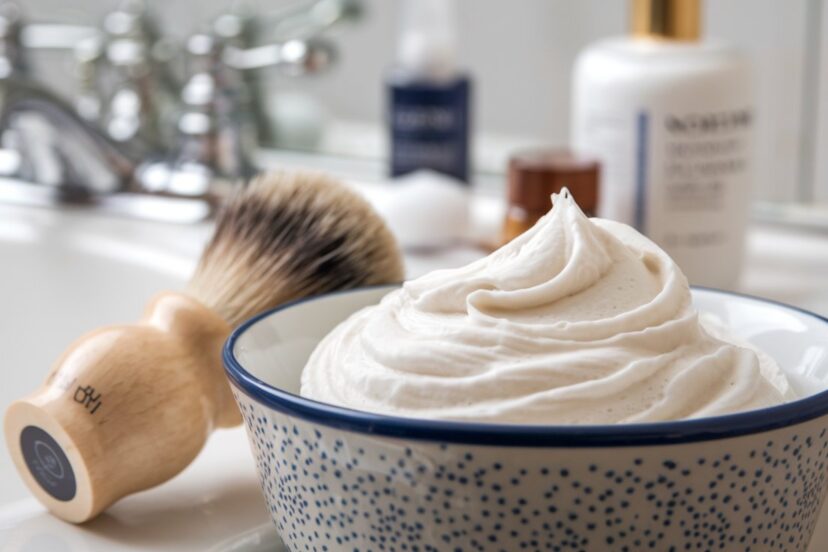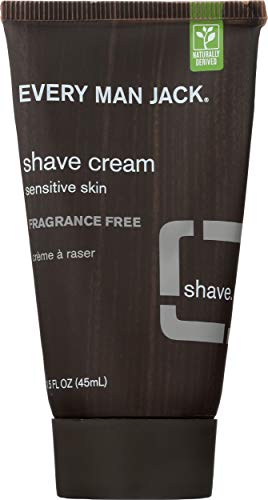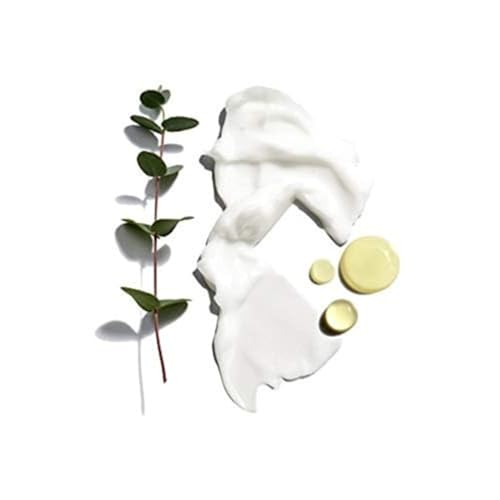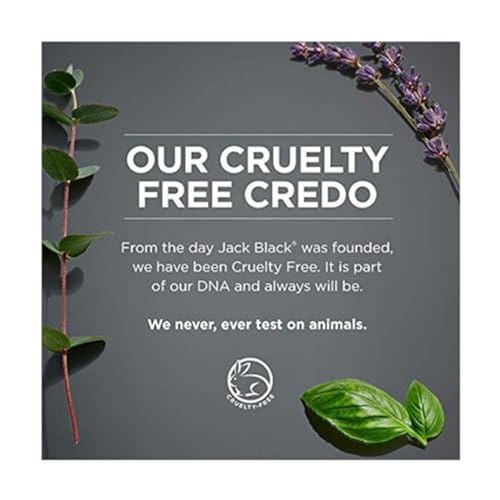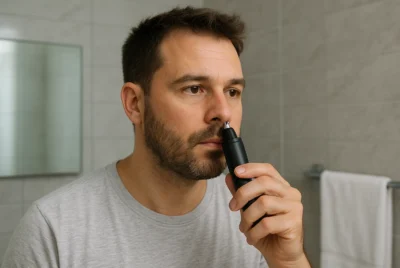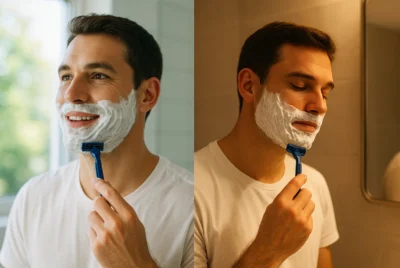Non-Comedogenic Shaving Cream: A Complete Guide
Post Disclaimer
*We may earn a commission for purchases made using our links. Please see our disclosure to learn more.
Finding the perfect shaving cream can feel like searching for a needle in a haystack, especially when you’re concerned about breakouts. I discovered this firsthand after years of post-shave acne frustration. The revelation came when I learned about non-comedogenic shaving creams, products specifically formulated not to clog pores.
For anyone who’s experienced the disappointment of a great shave followed by irritated skin and new pimples the next day, this guide is for you. I’ve spent countless hours researching, testing, and consulting with dermatologists to understand what makes a shaving cream truly non-comedogenic and which products deliver the best results.
Whether you have naturally acne-prone skin or simply want to prevent occasional breakouts, switching to a non-comedogenic shaving cream could be the solution you’ve been looking for. In this comprehensive guide, I’ll share everything I’ve learned about these specialized products and how they can transform your shaving routine.
Key Takeaways
- Non-comedogenic shaving creams don’t contain ingredients that clog pores, making them ideal for acne-prone skin
- Look for key ingredients like aloe vera, tea tree oil, and salicylic acid that soothe skin while fighting acne
- Avoid comedogenic ingredients such as mineral oil, coconut oil, and certain alcohols that can trigger breakouts
- Using non-comedogenic options can reduce post-shave breakouts and irritation significantly
- These products work well for all skin types, but particularly benefit those with oily or acne-prone skin
- The proper shaving technique is just as important as the product you choose for preventing breakouts
Top 4 Non-Comedogenic Shaving Creams
After testing dozens of products and consulting with dermatologists, these are my top recommendations:
1. Every Man Jack Sensitive Skin Shaving Cream
Achieve a smooth, irritation-free shave with Every Man Jack Unscented Cream Shave. This rich, hydrating formula softens and preps your skin and beard for a close, comfortable shave. Made without parabens, dyes, or fragrances, it's perfect for all skin types, including sensitive skin. Compact and travel-friendly, this 1.5 fl oz bottle is ideal for grooming on the go.
- Hydrating: Moisturizes and soothes skin while shaving.
- Gentle Formula: Fragrance-free and paraben-free, ideal for sensitive skin.
- Travel-Friendly: Compact 1.5 fl oz size for easy portability.
- Small Size: May not last long for daily use.
- No Lather: Does not create a foamy lather, which some may prefer.
- Mixed Reviews: Average customer rating suggests varying experiences.
This fragrance-free formula is packed with aloe and chamomile to soothe sensitive skin while providing a clean, close shave. The natural oils used are non-comedogenic, and it’s free of parabens, phthalates, and dyes that can irritate skin. The lightweight consistency creates a transparent layer that allows for precision shaving without clogging pores.
Key Features:
- Fragrance-free for sensitive skin
- Contains glycerin for smooth glide
- Aloe vera and chamomile for soothing
- No parabens or phthalates
- Cruelty-free and vegan
2. Vanicream Shave Cream
Vanicream Shave Cream is specially designed for sensitive skin, offering a soothing and irritation-free shaving experience. Its ultra-gentle, non-lathering formula provides a smooth glide, reducing nicks and razor burns while keeping skin hydrated and comfortable. Dermatologist-tested and free from harsh chemicals, including fragrances, dyes, parabens, and sulfates, this shave cream ensures a safe and effective shave for all skin types.
- Ultra-Gentle: Soothes and protects sensitive skin, minimizing irritation.
- Hydrating: Moisturizes skin, leaving it soft and smooth.
- Free of Harsh Ingredients: No fragrances, dyes, parabens, or sulfates.
- Non-Lathering: May not appeal to those who prefer a foamy shave cream.
- Mild Glide: Some users may prefer a slicker formula for razor movement.
- Price Fluctuations: Can vary in price depending on promotions and availability.
Developed by a trusted brand in sensitive skincare, Vanicream Shave Cream is designed to provide a smooth, irritation-free shaving experience. Its ultra-gentle, non-lathering formula creates a protective barrier that helps prevent razor burn and redness while keeping skin soft and hydrated. Free from harsh chemicals, fragrances, and dyes, this dermatologist-tested shave cream is perfect for those with sensitive or allergy-prone skin.
Key Features:
- Dermatologist-Tested: Clinically proven safe for sensitive skin.
- Non-Lathering Formula: Ensures a controlled, smooth glide to reduce nicks.
- Moisturizing & Soothing: Hydrates skin and prevents post-shave irritation.
- Free from Harsh Ingredients: No fragrances, dyes, parabens, or sulfates.
- Rinses Clean: Leaves no residue for a fresh, comfortable finish.
3. Cremo Original Shave Cream
Cremo Original Shave Cream is designed to deliver a close, comfortable shave with its ultra-slick, barber-grade formula. Its unique molecules create a smooth surface that helps razors glide effortlessly, reducing nicks, cuts, and irritation. Infused with a fresh, clean scent, this high-performance shave cream provides a luxurious experience at home. A little goes a long way, each 6 oz bottle lasts up to 90 days, making it a long-lasting and cost-effective choice for your grooming routine.
- Ultra-Slick Formula: Allows for a smooth, irritation-free shave.
- Long-Lasting: A 6 oz bottle provides up to 90 days of use.
- Barbershop Quality: Delivers a professional shaving experience at home.
- Non-Lathering: May not appeal to those who prefer foamy shave creams.
- Strong Scent: Some users may find the fragrance overpowering.
- Slickness Adjustment: May take time to get used to its unique glide.
Cremo’s concentrated formula requires only a small amount to create a slick surface that helps prevent nicks and cuts. Free from common comedogenic ingredients, it uses macadamia seed oil and aloe (both non-comedogenic) to condition skin without clogging pores. The unique formulation focuses on reducing friction rather than creating foam, which helps protect acne-prone skin.
Key Features:
- Super-concentrated formula (one tube lasts months)
- Slick surface reduces razor drag
- Contains aloe vera and macadamia seed oil
- No air-whipped foam that dries skin
- Made in the USA
4. Jack Black Beard Lube Conditioning Shave
Jack Black Beard Lube Conditioning Shave is a premium, three-in-one formula that functions as a pre-shave oil, shaving cream, and skin conditioner. Designed for a smooth, irritation-free shave, it softens facial hair, locks in moisture, and provides a slick surface for effortless razor glide. Infused with soothing ingredients like macadamia nut oil and heather, this lightweight formula helps reduce razor burn while keeping the skin hydrated and refreshed.
- 3-in-1 Formula: Works as a pre-shave oil, shaving cream, and conditioner.
- Moisture-Rich: Locks in hydration for a smoother shave.
- Skin-Soothing Ingredients: Reduces irritation with botanical extracts.
- Higher Price Point: More expensive compared to standard shave creams.
- Non-Lathering Texture: May not suit those who prefer traditional foamy creams.
- Thin Consistency: Might require more product for a thicker application.
This 3-in-1 pre-shave oil, shave cream, and skin conditioner is particularly excellent for those who deal with ingrown hairs along with acne. The transparent formula allows you to see exactly where you’re shaving, preventing over-shaving sensitive areas. Its lightweight consistency won’t clog pores, while jojoba oil and glycerin provide moisture without heaviness.
Key Features:
- Transparent formula for precision shaving
- Contains phospholipids to bind moisture to skin
- Includes jojoba oil, macadamia nut oil, and glycerin
- Fragrance-free option available
- PEG-free formula
Understanding Non-Comedogenic Shaving Creams
When I first heard the term “non-comedogenic,” I had to look it up. Essentially, “comedogenic” refers to ingredients that clog pores and can lead to comedones (blackheads and whiteheads), which often develop into inflammatory acne. Non-comedogenic products, therefore, are formulated without these pore-clogging ingredients.
Traditional shaving creams often contain heavy oils, waxes, and other ingredients that can remain on the skin after rinsing, penetrating open pores—especially after shaving when pores are more exposed. For those of us with acne-prone skin, this is a recipe for disaster.
Why Regular Shaving Creams Can Cause Breakouts
When I look back at my worst acne flare-ups, many coincided with changes to my shaving routine. Here’s why conventional shaving creams can be problematic:
- Heavy moisturizing agents: Many shaving creams use comedogenic oils to provide slip and moisture.
- Artificial fragrances: These can irritate skin and trigger inflammation, worsening acne.
- Alcohol content: Some contain drying alcohols that strip skin of natural oils, leading to overproduction of sebum.
- Sulfates: These can disrupt the skin barrier and cause irritation.
- Thick consistency: Heavier creams may not rinse completely clean, leaving residue that clogs pores.
During shaving, we’re not just removing hair, we’re also exfoliating the top layer of skin. This makes the timing of applying potentially comedogenic ingredients particularly problematic, as freshly shaved skin absorbs products more readily.
Benefits of Switching to Non-Comedogenic Options
Since switching to non-comedogenic shaving creams, I’ve noticed several improvements:
- Fewer post-shave breakouts: The most obvious benefit is the reduction in acne after shaving.
- Less irritation: These formulas tend to be gentler overall.
- Better healing: Existing acne heals faster without additional irritation.
- Improved skin texture: With fewer breakouts, my skin’s overall texture has improved.
- More comfortable shaves: Many non-comedogenic options still provide excellent lubrication.
What to Look For in Non-Comedogenic Shaving Creams
When I’m shopping for new shaving products, I focus on these factors:
Beneficial Ingredients to Seek Out
- Aloe Vera: Soothes irritation and provides natural moisture without clogging pores.
- Tea Tree Oil: Has natural antibacterial properties that can help prevent breakouts.
- Glycerin: Provides slip and moisture without heaviness.
- Salicylic Acid: Can actually help treat existing acne while preventing new breakouts.
- Allantoin: Helps calm irritation and promote healing.
- Light, Non-Comedogenic Oils: Like jojoba oil, which closely resembles skin’s natural sebum.
Ingredients to Avoid
I’ve learned to scan ingredient lists for these common offenders:
- Mineral Oil: A petroleum by-product known to clog pores.
- Coconut Oil: Despite its popularity in natural products, it’s highly comedogenic.
- Cocoa Butter: Too heavy for acne-prone facial skin.
- Isopropyl Myristate: Used as a binding agent but known to cause breakouts.
- Sodium Lauryl Sulfate: Can irritate skin and disrupt its natural balance.
- Artificial Fragrances: Often listed simply as “fragrance” or “parfum.”
Product Consistency Matters
I’ve found that gel-based or lightweight cream formulas tend to work better than thick, rich creams. They rinse away more completely and are less likely to leave pore-clogging residue behind.
Proper Shaving Technique for Acne-Prone Skin
Even the best non-comedogenic shaving cream won’t help if your shaving technique is working against you. Here’s the routine I’ve developed:
- Pre-shave preparation: I always shower or wash my face with warm water before shaving to soften hair and open pores.
- Gentle exfoliation: Using a mild exfoliant (like a salicylic acid cleanser) before shaving helps prevent ingrown hairs and removes dead skin cells.
- Use only fresh, sharp razors: Dull blades require more pressure and cause more irritation.
- Shave with the grain: Going against the grain might give a closer shave but greatly increases irritation and the risk of ingrown hairs.
- Rinse thoroughly: I make sure to rinse all product residue from my skin after shaving.
- Apply alcohol-free aftershave: Look for soothing ingredients like witch hazel or aloe vera.
- Moisturize properly: Finish with a non-comedogenic moisturizer to restore the skin barrier.
I’ve found that shaving every other day, rather than daily, also helps my skin recover and reduces breakouts significantly.
Non-Comedogenic Shaving Creams for Different Skin Types
While I’ve focused on acne-prone skin, non-comedogenic options benefit various skin conditions:
Oily Skin
If you have naturally oily skin, look for oil-free formulas with ingredients like tea tree oil or salicylic acid that can help control excess sebum production. Gel-based formulas tend to work especially well.
Sensitive Skin
For sensitive skin that’s also acne-prone, fragrance-free options with soothing ingredients like aloe vera, chamomile, and allantoin are ideal. Avoid formulas with alcohol, menthol, or eucalyptus, which can cause stinging or irritation.
Dry or Combination Skin
If parts of your face tend to be dry while others are acne-prone, look for balanced formulas with light hydration from ingredients like glycerin and jojoba oil, which moisturize without clogging pores.
DIY Alternatives
When I’ve run out of my regular products, I’ve experimented with these DIY alternatives that don’t clog pores:
- Aloe vera gel: Pure aloe vera provides slip without clogging pores. It’s not as lubricating as commercial products but works in a pinch.
- Diluted hair conditioner: A tiny amount of non-comedogenic conditioner can work as an emergency shaving cream.
- Jojoba oil: Just a few drops can provide enough lubrication for a razor to glide smoothly.
While these aren’t perfect replacements, they’re better than using comedogenic products if you’re caught without your regular shaving cream.
How to Transition to Non-Comedogenic Products
When I first made the switch, I noticed that giving my skin time to adjust was important. Here’s what worked for me:
- Start with a clean slate: Before switching products, I thoroughly cleansed my face and used a gentle exfoliant to remove any residue from previous products.
- Patch test first: I tested new products on a small area of my neck for a few days before applying to my entire face.
- Be patient: It took about two weeks for my skin to fully adjust and show the benefits of the switch.
- Maintain consistency: Sticking with the new product and not mixing with old comedogenic creams was crucial for seeing results.
The Science Behind Comedogenic Ingredients
Understanding why certain ingredients cause breakouts helped me make better choices. Comedogenic ingredients typically either:
- Create an occlusive barrier: They sit on top of the skin, trapping bacteria, oil, and dead skin cells inside pores.
- Disrupt the skin’s natural barrier: They can alter the skin’s pH or damage its protective layer, leading to increased vulnerability to bacteria and inflammation.
- Promote excess oil production: Some ingredients signal the skin to produce more sebum, worsening already oily or acne-prone skin.
Dermatologists rate ingredients on a comedogenicity scale from 0 (non-comedogenic) to 5 (highly comedogenic). Products containing ingredients rated 2 or lower are generally safe for acne-prone skin.
Conclusion
Finding the right non-comedogenic shaving cream has been a crucial piece of my clear skin puzzle. While it might seem like a small detail in a skincare routine, for those of us who shave regularly and deal with acne, it can make a dramatic difference.
The products I’ve recommended here have all been tested personally or come highly recommended by dermatologists specifically for acne-prone skin. Remember that everyone’s skin is different—what works perfectly for me might not be your ideal match, but these options provide a solid starting point.
Beyond the product itself, paying attention to your shaving technique and overall skincare routine will maximize your results. Consistency is key—stick with a product for at least a few weeks to truly gauge its impact on your skin.
If you’re currently dealing with breakouts after shaving, I hope this guide helps you find a solution. The right non-comedogenic shaving cream might just be the change your skin has been waiting for.
Frequently Asked Questions
1. Can women use non-comedogenic shaving creams for their legs and underarms?
Absolutely! While my experience is primarily with facial shaving, the same principles apply to any area of the body. Non-comedogenic shaving creams can be especially helpful for preventing breakouts in underarm areas or along the bikini line, where hair removal often triggers acne.
2. How can I tell if a shaving cream is truly non-comedogenic if it doesn’t say so on the label?
This is something I struggled with initially. While “non-comedogenic” on the label is helpful, you can also check the ingredient list against comedogenicity ratings available online. Ingredients rated 0-2 on the 0-5 comedogenic scale are generally safe for acne-prone skin. Look for terms like “oil-free” or “won’t clog pores” as well.
3. Is it better to use a shaving brush with non-comedogenic creams?
It depends on your skin’s sensitivity. A clean, high-quality shaving brush can create a rich lather with less product and gently exfoliate the skin. However, if you have active acne, the mechanical action of the brush might irritate inflamed areas. I personally find applying with clean fingers works best when my skin is breaking out.
4. How long should I wait to see improvements after switching to non-comedogenic shaving cream?
In my experience, you should notice fewer new breakouts within 1-2 weeks of switching. However, complete improvement may take longer, especially if you have existing acne that needs to heal. Give any new product at least a month before making a final judgment on its effectiveness.
5. Can I use non-comedogenic shaving cream with an electric razor?
Most non-comedogenic shaving creams work best with traditional razors rather than electric shavers. However, some lighter gel formulas can work with wet/dry electric razors. If you prefer electric shaving, look specifically for non-comedogenic pre-electric shaves, which are typically lighter in consistency and designed for use with electric razors.

